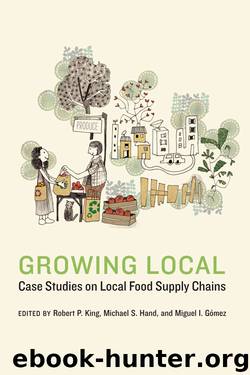Growing Local by Unknown

Author:Unknown
Language: eng
Format: epub
Tags: BUS070010 Business & Economics / Industries / Agribusiness
ISBN: 9780803258167
Publisher: University of Nebraska Press
Published: 2014-11-17T16:00:00+00:00
Cut
Yield (lb)
Cut
Yield (lb)
Ribeye
24
Roasts
64
NY Strip
20
Ribs and Brisket
26
Tenderloin
9
Stew Meat/Stir Fry/Other
42
Sirloin
24
Ground Beef
285
Total Yield 494 lb
Source: This is based on an example in a document that describes the beef cutout calculator (National Cattlemen’s Beef Association n.d.).
Marketing and Retail Operations
The meat department in each Kowalski’s store includes backroom facilities for cutting, trimming, and packaging meat from boxed beef primal and subprimals; a full-service custom meat counter; and self-service refrigerator and freezer cases. Meat and seafood account for approximately 12.5 percent of sales in a typical Kowalski’s store, and beef product sales represent approximately one-third of meat and seafood sales. With $425,000 average weekly sales at the Grand Avenue store, weekly sales of meat and seafood are approximately $53,125 and weekly sales of beef products are approximately $17,700. Kowalski’s All Natural beef products are labeled “Kowalski’s Premium All Natural Beef. No added hormones/antibiotics! Source verified. Product of the USA. USDA Choice/Prime.” This provides the consumer with information about production methods, quality, and country of origin.
Oase notes that Kowalski’s tries to price beef products so that over time the mix of cuts purchased comes close to matching the cutout from whole animals. Median prices for “Kowalski’s All Natural” 85 and 87 percent lean ground beef and ribeye steak in the Grand Avenue store during 2009 were $3.99/lb and $13.99/lb, respectively.
Table 15 shows a sample whole-animal cutout for a 1,300-pound steer supplied through Creekstone. This assumes a hot carcass weight of 800 pounds and an estimated retail yield of 494 pounds of beef. With the exception of product specials, beef prices in Kowalski’s stores are relatively stable—varying only in response to longer-term fluctuations in national beef prices.
For calculations in this case study, we estimate the 2009 retail value of the meat from one steer to be approximately $3,054. Assuming a 50 percent markup on cost, this implies a wholesale cost of approximately $2,037, with $750 of that going to Creekstone and J&B and the remainder to the producer/finisher.
Food Miles and Transportation Fuel Use
Meat sold in the Kowalski’s Grand Avenue store typically moves through a five-segment supply chain from cow-calf producer to the retail location. Calves, weighing 600–650 pounds, are transported from Nebraska and surrounding states to farms like those owned by the Verdoes in Marshall, Minnesota, for finishing. A trip from the cow-calf operation to the Verdoes finishing lot is 250 miles one way and requires 83.3 gallons of diesel fuel for the roundtrip. Assuming that 55 live feeder cattle, which will eventually yield 27,200 pounds of meat, are hauled by semi-trailer, this implies fuel use of 0.31 gal/cwt of meat. Once ready for slaughter, live animals weighing 1,300–1,350 pounds are transported by semi-truck to Creekstone, 615 miles away in Arkansas City, Kansas, for processing. Each semi-truck of slaughter-weight steers can haul 40 animals, which will eventually yield 19,800 pounds of meat. The roundtrip requires 205 gallons of diesel fuel or 1.04 gal/cwt of meat. After processing, J&B arranges for transport of the finished meat to its distribution facility 720 miles away in St. Michael, Minnesota, and finally another 60 miles to Kowalski’s Grand Avenue store using a semi-truck.
Download
This site does not store any files on its server. We only index and link to content provided by other sites. Please contact the content providers to delete copyright contents if any and email us, we'll remove relevant links or contents immediately.
Kathy Andrews Collection by Kathy Andrews(11760)
The remains of the day by Kazuo Ishiguro(8886)
Paper Towns by Green John(5136)
Spare by Prince Harry The Duke of Sussex(5132)
The Body: A Guide for Occupants by Bill Bryson(5025)
Industrial Automation from Scratch: A hands-on guide to using sensors, actuators, PLCs, HMIs, and SCADA to automate industrial processes by Olushola Akande(5024)
Machine Learning at Scale with H2O by Gregory Keys | David Whiting(4256)
Be in a Treehouse by Pete Nelson(3996)
Never by Ken Follett(3874)
Harry Potter and the Goblet Of Fire by J.K. Rowling(3803)
Goodbye Paradise(3760)
Into Thin Air by Jon Krakauer(3346)
The Remains of the Day by Kazuo Ishiguro(3341)
Fairy Tale by Stephen King(3305)
The Cellar by Natasha Preston(3293)
The Genius of Japanese Carpentry by Azby Brown(3253)
120 Days of Sodom by Marquis de Sade(3223)
The Man Who Died Twice by Richard Osman(3037)
Drawing Shortcuts: Developing Quick Drawing Skills Using Today's Technology by Leggitt Jim(3036)
